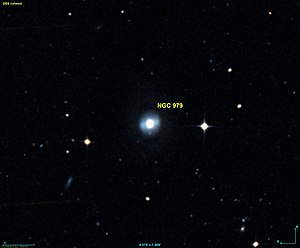NGC 979
| Galaxy NGC 979 |
|
|---|---|

|
|
| AladinLite | |
| Constellation | Eridanus |
|
Position equinox : J2000.0 , epoch : J2000.0 |
|
| Right ascension | 02 h 31 m 38.8 s |
| declination | -44 ° 31 ′ 28 ″ |
| Appearance | |
| Morphological type | (R) SB (rl) 0 ^ 0 |
| Brightness (visual) | 12.8 mag |
| Brightness (B-band) | 13.8 mag |
| Angular expansion | 0.9 ′ × 0.7 ′ |
| Position angle | 0 ° |
| Surface brightness | 12.1 mag / arcmin² |
| Physical data | |
| Redshift | 0.017829 ± 0.000150 |
| Radial velocity | 5345 ± 45 km / s |
|
Stroke distance v rad / H 0 |
(234 ± 17) · 10 6 ly (71.7 ± 5.1) Mpc |
| history | |
| discovery | John Herschel |
| Discovery date | October 18, 1835 |
| Catalog names | |
| NGC 979 • PGC 9614 • ESO 246-023 • MCG -07-06-014 • 2MASX J02313876-4431273 • GALEXASC J023138.70-443126.5 • LDCE 0164 NED014 | |
NGC 979 is a lenticular galaxy of the Hubble type SB0 in the constellation Eridanus south of the celestial equator . It is estimated to be 234 million light years from the Milky Way and about 60,000 light years in diameter.
The object was discovered by John Herschel on October 18, 1835 .
Web links
Commons : NGC 979 - collection of images, videos, and audio files
